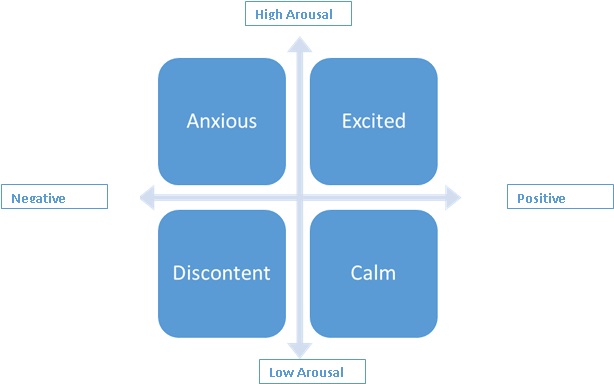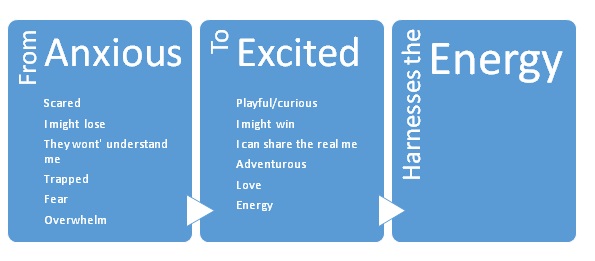
A Coaching Power Tool Created by Marian Gibbs
(Career Coach, NEW ZEALAND)
‘I’ve lived through some terrible things in my life, some of which actually happened’ (attributed to) Mark Twain
A meeting with the boss (or the next one up), presenting to a new group, or even just trying to juggle the mounting workload can push our comfort zone. Think about the last time you had to do something that tested your boundaries and set your blood pumping. What was the inner monologue? Did you imagine all the terrible things that could happen? Tell yourself to calm down, that it would be alright? Did you try and see the positives about the situation? Or something else perhaps?
Even though we may want to grow and develop (which is exactly the potential in these situations), our body sometimes tells us something else. It can really be difficult to keep ourselves on track – before you know it, anxiety takes over.
So what does Anxiety feel like? It has been defined (McConnell, Bill, Dember, & Grasha, 1993) as:
negative appraisal; uncertainty and a lack of control.
And what does it do to us?
Anxiety drains working memory capacity; decreases self-confidence and harms. (Eysenck, 1992).
So not only does our brain stop working as effectively, but we doubt whether we can succeed. Double-whammy then.
As a Coach, what can we do to help our clients push through those moments of anxiety?
What do you think our client would say if you asked them ‘what approaches could you take’ or ‘how could you reframe this?’.
The typical suggestion they may make for themselves would surely be to ‘calm down’ (interestingly, 92% of people recommended this approach in the research I’m about to share with you). ‘Take a deep breath’, ‘imagine your audience naked’ are all variations on this idea. However, when you are already in a state of anxiety (your breathing is rushed, blood pressure pumping, it is often much easier said than done, as there is an ‘emotional hijacking’ that stops you accessing the full range of your logical powers. (Goleman, 1995).
How about ‘fake it till you make it’ then? And how can you maintain an authenticity with this approach? And what expectation does it create that we shouldn’t demonstrate ‘real’ feelings (such as nerves, worry, etc).
Interestingly though, when you look at the research:
So perhaps there is indeed some logic to it after all. Another perspective on the ‘fake it’ adage, is Gretchen Rubin’s premise that we should ‘act the way you want to feel’ (2011). This, seems like an improvement of the ‘fake it’ adage, neatly encapsulating the constructive (we can reach past our fears), without the false (don’t show your humanness/fears).
So how effective are these approaches?
A Harvard University study conducted in 2014 tried to work this out. They introduced and tested the premise that instead of encouraging ourselves to calm down, we would better shifting towards excitement. Why excitement? Their logic was that both anxiety and excitement are actually similar in that they are both highly aroused states (ie: high blood pressure; shortness of breath, etc), just at opposite ends of the negative/positive spectrum. The diagram below demonstrates this:
 The study had participants complete a variety of anxiety-inducing situations (singing in front of others; difficult math questions & presenting in front of a group), with a range of pre-performance self-talk instructions given including:
The study had participants complete a variety of anxiety-inducing situations (singing in front of others; difficult math questions & presenting in front of a group), with a range of pre-performance self-talk instructions given including:
- Be calm
- Get Excited
- No instruction given
When testing the, the results showed that for those given no instruction or asked to stay calm, performance was similar. However, the participants who were asked to get excited showed performance improvements across all the dimensions measured (such as singing in tune; accuracy on math questions; and quality of presentation (such as confidence; competence; persuasiveness, persistence and duration).
No more ‘Keep Calm and Carry On’ then?
The argument here is that once you are already anxious, it’s too late. The blood is pumping, your hands are sweating, thoughts are spinning around your head. Attempting to calm down is:
- difficult to achieve; in addition,
- it creates an opportunity for rumination, right at the point of time when you want to get your best foot forward.
Instead, reframing the anxiety as excitement allows you to harness that nervous energy into a positive and curious mindset – a mindset of opportunity, rather than a threat mind-set.
Of course creating a sense of calm in the first place and tools to maintain your cool are important tools to have in your tool box for life. However, once ‘the horse has bolted’, it’s easier to frame the ‘ride’ as an adventure, than to try to slow the horse down again. And (according to the study), you’ll find you ride the horse better too!
So what are we Moving From/To:
Using this power tool with your client gives them a really simple way to move from Anxious to Excited. If you were to describe what you would see, it might look something like this:

Other Related Coaching Concepts
Lightness v Significance (LvS): this is a similar but different Power Tool. LvS is really useful in the process of recognising your own self-judgement on a past event. And both of these tools are great at lifting a weight off a client’s perspective. LvS works especially well when a client is in that place of ‘discontent’ (ie: low anxiety).
However, the Anxious to Excited Power Tool really hones in on one aspect: when the ‘weight’ converts to anxiety (high anxiety). The AvE tool enables a client to channel the nervous energy that already exists within them at that moment when they really need it (when the best parts of their brain has been ‘hijacked’). It can be readily applied to the next little moment of anxiety (which is often not far away), rather than waiting for the next significant moment of anxiety (we may not need to perform in public for a very long time!).
Coaching Application
There are a number of ways in which this can be a useful tool in your Coaching Practice.
Exercises:
Reflection for Coaches
Think about the last time you felt anxious. What did it feel like? How did you behave? What self-talk did you give yourself? What was the result?
Think about the last time you felt excited about something? What did it feel like? How did you behave? What self-talk did you give yourself? What was the result?
Where could you apply this ‘get excited’ challenge to yourself?
In Conclusion
Albert Einstein once said:
Energy cannot be created or destroyed, it can only be changed from one form to another.
So here is a tool for taking that source of energy (high arousal) which is negative and taxing, to one that is positive and life-affirming. Perhaps then, with application of this power tool, we can change up Mark Twain’s opening phrase to:
I’ve lived through some wonderful things in my life, many which have happened.
Further Resources/Reading:
“Get Excited: Reappraising Pre-Performance Anxiety as Excitement” Alison Wood-Brooks, 2014:
http://www.hbs.edu/faculty/Publication%20Files/xge-a0035325%20(2)_0287835d-9e25-4f92-9661-c5b54dbbcb39.pdf
“Emotional Intelligence” Daniel Goleman, 1995
http://www.scientificamerican.com/article/smile-it-could-make-you-happier/
Summary of Arousal studies
https://en.wikipedia.org/wiki/Misattribution_of_arousal